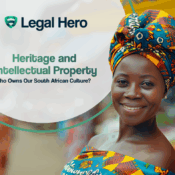
Heritage and Intellectual Property: Who Owns Our South African Culture?
By Jolané van der Walt-Nieuwoudt and Simone Steinmair-Myburgh
South Africa’s culture is living, shared and valuable. When heritage meets markets and research, uncomfortable questions arise. Who owns what? Who may use it? Who benefits?
This updated guide improves flow and integrates key phrases such as heritage and intellectual property South Africa, Indigenous Knowledge Act, Access and Benefit Sharing (ABS) and bioprospecting permits under NEMBA to help readers act lawfully and respectfully.
Why ownership of culture is complex
Heritage is often collective. Songs, stories, designs and traditional knowledge flow through generations and across communities. South African law recognises this communal nature and increasingly aligns protection, consent and benefit-sharing with cultural realities rather than private, individual control.
The legal baseline for heritage and intellectual property South Africa
South African law protects cultural participation and frames heritage as a national asset. The National Heritage Resources Act places stewardship with the state in the public interest and recognises the national estate. At the same time, modern intellectual property law offers tools to prevent exploitation and to channel value back to originators and custodians.
Key principles
- Custodianship over ownership: Communities hold, use and transmit knowledge; the law increasingly centres their role.
- Consent and fairness: Ethical use requires prior agreement and fair terms, not after-the-fact acknowledgement.
- Documentation: Clear records of origin, permissions and benefits reduce conflict and enable compliance.
Indigenous Knowledge Act: recognising communities and their rights
The Protection, Promotion, Development and Management of Indigenous Knowledge Act, 2019 establishes the National Indigenous Knowledge Systems Office (NIKSO) and a registry. Registering indigenous knowledge helps communities identify custodianship and license use. It enables remedies against misappropriation and creates a bridge between customary practices and formal IP systems.
What it means in practice:
- Communities can licence registered indigenous knowledge on agreed terms.
- Users must seek consent and negotiate benefits where knowledge is accessed and commercialised.
- Enforcement mechanisms exist if use occurs without approval.
ABS under NEMBA: permits for research and product development
If your work uses South African indigenous biological resources or traditional knowledge associated with those resources, the National Environmental Management: Biodiversity Act (NEMBA) may apply.
The bioprospecting and biotrade frameworks require:
- An ABS (Access and Benefit-Sharing) agreement with identified stakeholders.
- Bioprospecting or export permits before research, publication or commercialisation.
- Ongoing reporting and fair benefit-sharing that can include royalties, skills transfer and community projects.
Skipping ABS risks legal penalties and lost partnerships. Building it in early protects projects and relationships.
When culture meets commerce: available IP tools
No single statute covers all cultural expressions. Instead, South Africa uses a toolbox approach:
- Copyright and Performers’ Protection: Protect original works and performances.
- Designs Act: Safeguard aesthetic features of craft and pattern where registrable.
- Trade Marks: Individual, collective or certification marks can signal authenticity and community standards.
- Geographical Indications (GIs): Link product reputation to place, preventing misleading use and encouraging premium pricing.
- Common-law passing off: Stops misrepresentation that harms goodwill.
Use these tools with community consent and fair terms. They work best when coupled with provenance documentation.
Case signals: from extraction to recognition
- Hoodia and the San: Early disputes over appetite-suppressant research led to benefit-sharing with San communities. The lesson is clear: engagement and fair returns must be built in from the start.
- Rooibos PDO: “Rooibos/Red Bush” gained EU Protected Designation of Origin recognition. Only tea from defined South African regions may use the name, aligning economic value with cultural and geographic origin.
These examples show a shift from “first come, first served” to consent, recognition and benefit.
Practical steps for brands, researchers and NGOs
- Map your inputs. Identify any indigenous knowledge, traditional cultural expressions or biological resources in your concept, research or supply chain.
- Engage early. Contact NIKSO for guidance on indigenous knowledge registration and licensing. Consult the Department of Forestry, Fisheries and the Environment on bioprospecting permits and ABS.
- Agree on benefits. Blend upfront fees with royalties, capacity-building, local jobs or co-created projects. Put community governance and dispute resolution in writing.
- Choose the right IP instruments. Consider collective or certification trade marks, designs and, where applicable, GIs to signal authenticity and prevent misuse.
- Keep records. Document provenance, permissions, material transfers and approvals. This reduces risk and speeds up audits and partnerships.
- Communicate respectfully. Use accurate language for communities, practices and places. Avoid tokenism and misrepresentation.
FAQs
Does registering indigenous knowledge privatise culture?
No. Registration recognises custodianship and enables licensing and remedies. It does not convert living culture into blanket private property.
Do I need a permit if I am only publishing research?
Likely yes, if your work uses indigenous biological resources or associated traditional knowledge. ABS and bioprospecting permits often apply before publication or export.
Can I use a community name for a product?
Proceed with caution. Assess trade mark availability, passing-off risk and community impact. Seek consent and consider collective marks or co-branding.
Conclusion: protect culture, share value, stay compliant
South Africa’s legal framework supports respectful use of culture and biodiversity. Align your work with Indigenous Knowledge Act processes, ABS under NEMBA, and suitable IP tools so communities benefit and your project stands up to scrutiny.
Need help navigating heritage and intellectual property in South Africa? Speak to Legal Hero for plain-language advice on NIKSO engagement, bioprospecting permits, ABS agreements and brand protection that honours culture. Know your rights and act with respect.



